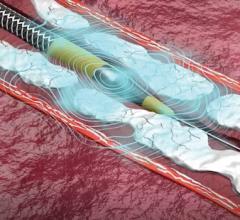May 15, 2017 — For patients who undergo transcatheter aortic valve replacement (TAVR), their risk factors, not the type of valve used, determined their 30-day post-TAVR outcomes. Results from “Impact of valve design and bivalirudin vs. unfractionated heparin for anticoagulation in transcatheter aortic valve replacement: Results from the BRAVO-3 trial” were presented as a late-breaking clinical trial at the Society for Cardiovascular Angiography and Interventions (SCAI) 2017 Scientific Sessions, May 10-13 in New Orleans.
TAVR is performed in intermediate- or high-risk patients with significant symptomatic aortic valve stenosis, who are deemed suitable for the procedure following heart team assessment. In the past 10 years, more than 100,000 TAVR valves have been implanted, with several device improvements during that time.
This pre-specified subgroup analysis from the BRAVO-3 trial included 500 patients undergoing transfemoral TAVR with balloon-expandable valves (BE) and 282 patients with non-BE valves. Although selection of valve type was at operator’s discretion, randomization to bivalirudin (BIV) or unfractionated heparin (UFH) was stratified by valve type.
Results demonstrated that the two-thirds of TAVR patients receiving BE valves had a different baseline profile than patients treated with non-BE valves. Non-BE valve patients were older, had a higher euroSCORE I, but had lower rates of diabetes. They also had a trend for higher prevalence of chronic obstructive lung disease, lower left ventricular ejection fraction and lower body weight. Within the BE valve patient group, 251 were treated with BIV and 249 with UFH. Among non-BE patients, 140 were treated with BIV and 142 with UFH.
Although non-BE valve patients were more likely to require a second implant during the procedure, there were no significant differences in the adjusted endpoints between the groups. “This is not a one size fits all situation,” said Roxana Mehran, M.D., professor of medicine and director of interventional cardiovascular research and clinical trials at the Zena and Michael A. Weiner Cardiovascular Institute at Icahn School of Medicine at Mount Sinai. “It is not the differences in the valves, but differences in the patients. When we select the valve based on the patient’s characteristics, the outcomes are positive.”
Thirty-day clinical outcomes for BE patients were stroke (3 percent), death (3.8 percent), BARC major bleeding (9 percent), major vascular complications (8.4 percent), MACE (6.8 percent) and NACE (14.2 percent). Those treated with non-BE valves were stroke (3.6 percent), death (7.1 percent), BARC major bleeding (10.6 percent), major vascular complications (11 percent), MACE (10.6 percent) and NACE (17.7 percent).
The patients with non-BE valves exhibited a trend for higher adjusted risk of major vascular complications (OR 1.78, 95 percent CI 0.97-3.26, p = 0.062), which researchers note may be a function of available device generation during the study period. There was a borderline interaction noted between valve type and anticoagulation treatment for the occurrence of major vascular complications, suggesting that bivalirudin might be associated with lower risk in patients treated with non-BE valves.
The BRAVO-3 trial also showed more than one-third of patients undergoing TAVR were observed to have atrial fibrillation (AF) either at baseline or new-onset within 30 days after TAVR. Read the article “Analysis Shows Increased Risk of Early Stroke with New-Onset Atrial Fibrillation Post-TAVR,” from SCAI 2017.
For more information: www.scaiscientificsessions.org


 November 14, 2025
November 14, 2025 









